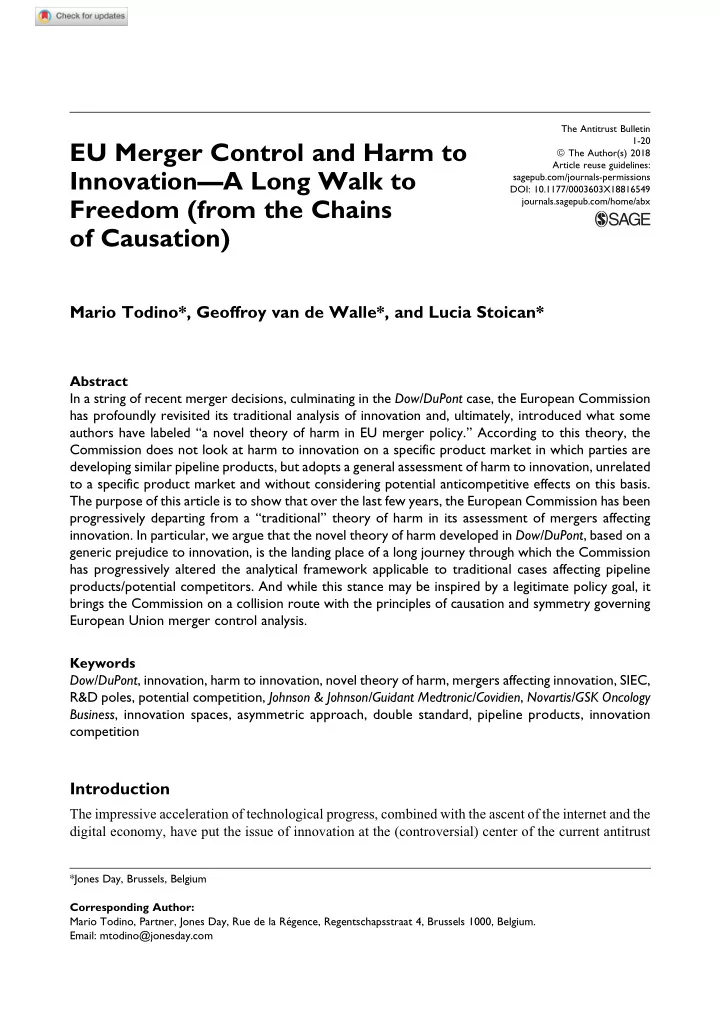

The Antitrust Bulletin 1-20 EU Merger Control and Harm to ª The Author(s) 2018 Article reuse guidelines: Innovation—A Long Walk to sagepub.com/journals-permissions DOI: 10.1177/0003603X18816549 journals.sagepub.com/home/abx Freedom (from the Chains of Causation) Mario Todino*, Geoffroy van de Walle*, and Lucia Stoican* Abstract In a string of recent merger decisions, culminating in the Dow/DuPont case, the European Commission has profoundly revisited its traditional analysis of innovation and, ultimately, introduced what some authors have labeled “a novel theory of harm in EU merger policy.” According to this theory, the Commission does not look at harm to innovation on a specific product market in which parties are developing similar pipeline products, but adopts a general assessment of harm to innovation, unrelated to a specific product market and without considering potential anticompetitive effects on this basis. The purpose of this article is to show that over the last few years, the European Commission has been progressively departing from a “traditional” theory of harm in its assessment of mergers affecting innovation. In particular, we argue that the novel theory of harm developed in Dow/DuPont , based on a generic prejudice to innovation, is the landing place of a long journey through which the Commission has progressively altered the analytical framework applicable to traditional cases affecting pipeline products/potential competitors. And while this stance may be inspired by a legitimate policy goal, it brings the Commission on a collision route with the principles of causation and symmetry governing European Union merger control analysis. Keywords Dow/DuPont , innovation, harm to innovation, novel theory of harm, mergers affecting innovation, SIEC, R&D poles, potential competition, Johnson & Johnson/Guidant Medtronic/Covidien , Novartis/GSK Oncology Business , innovation spaces, asymmetric approach, double standard, pipeline products, innovation competition Introduction The impressive acceleration of technological progress, combined with the ascent of the internet and the digital economy, have put the issue of innovation at the (controversial) center of the current antitrust *Jones Day, Brussels, Belgium Corresponding Author: Mario Todino, Partner, Jones Day, Rue de la R´ egence, Regentschapsstraat 4, Brussels 1000, Belgium. Email: mtodino@jonesday.com
2 The Antitrust Bulletin XX(X) debate. Innovation is increasingly seen by the European Commission as a key parameter of compe- tition, as businesses increasingly compete on research and development of new products or entirely new business models. This has in turn shifted the antitrust enforcement priorities of the enforcer, and it is no wonder that the rhetoric of innovation has become dominant in European Union (EU) merger control analysis. In a string of recent merger decisions, culminating in the Dow/DuPont case, 1 the European Com- mission has profoundly revisited its traditional analysis of innovation and, ultimately, introduced what some authors have labeled “a novel theory of harm in EU merger policy.” 2 According to this theory, the Commission does not look at harm to innovation on a specific product market in which parties are developing similar pipeline products but adopts a general assessment of harm to innovation, unrelated to a specific product market and without considering potential anticompetitive effects on this basis. The purpose of this article is to show that over the last few years, the European Commission has been progressively departing from a “traditional” theory of harm in its assessment of mergers affecting innovation. In particular, we argue that the novel theory of harm developed in Dow/DuPont , 3 based on a generic prejudice to innovation, is the landing place of a long journey through which the Commission has progressively altered the analytical framework applicable to traditional cases affecting pipeline products/potential competitors. And while this stance may be inspired by a legitimate policy goal, it brings the Commission on a collision route with the principles of causation and symmetry governing EU merger control analysis. This article is structured as follows: (1) In the first section, we set the stage by highlighting the factors that have led innovation to become the center piece of the Commission’s merger inter- vention. (2) In Section II, we briefly describe the traditional analytical framework the Commis- sion has employed to assess innovation in merger control and provide a short overview of some illustrative cases in point. (3) We then describe the Commission’s “new” approach in the Med- tronic/Covidien , 4 Novartis/Glaxosmithkline Oncology Business [GSK] , 5 and Dow/DuPont 6 cases. (4) In the last section, we explain how certain parameters relevant for the assessment of potential competition in merger cases have been altered and why these developments bear far-reaching implications. I. Background—Technological Progress and Digital Economy—Innovation as the Antidote to Market Power A. Innovation Is the Source of Technological Progress According to a number of distinguished scholars, over the past five decades, the evolution of global markets has been essentially driven by “competition in the market” whereby firms used to compete on traditional parameters (price and quality), while disruptive innovation remained relatively infrequent. Over the last few years, this landscape has completely changed. The rise of the Internet era has tilted 1. E UR . C OMM ’ N , Case M.7932, Dow/DuPont , Decision C(2017), http://ec.europa.eu/competition/mergers/cases/decisions/ m7932_13668_3.pdf (hereinafter, Dow/DuPont ). 2. Nicolas Petit, Significant Impediment to Industry Innovation: A Novel Theory of Harm in EU Merger Control? SSRN (Feb. 4, 2017), https://ssrn.com/abstract ¼ 2911597. 3. Dow/DuPont, supra note 1 . 4. E UR . C OMM ’ N , Case M.7326, Medtronic/Covidien , Decision C(2014)9215, http://ec.europa.eu/competition/mergers/cases/ decisions/m7326_20141128_20212_4138173_EN.pdf (hereinafter, Medtronic/Covidien ). 5. E UR . C OMM ’ N , Case M.7275, Novartis/Glaxosmithkline Oncology Business , Decision C(2015)538, http://ec.europa.eu/ competition/mergers/cases/decisions/m7275_20150128_20212_4158734_EN.pdf (hereinafter, Novartis/GSK ). 6. Dow/DuPont , supra note 1.
Recommend
More recommend